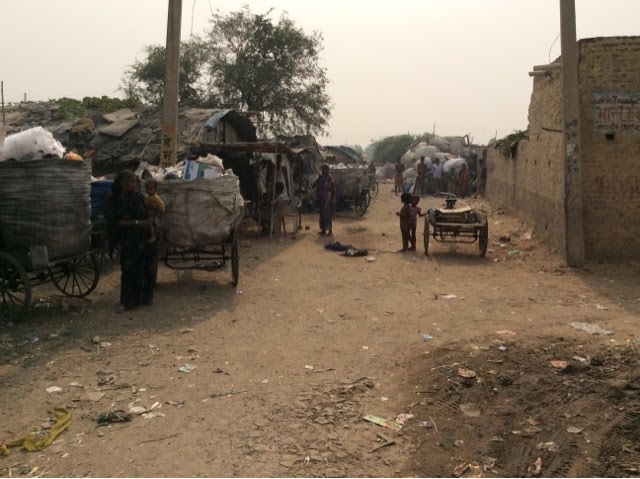Today, Anita took me back to the factory and then to the Conserve India School and adjacent slum.
The school building and Anita standing at the gate.
Students in the school.
The students in the school seem quite well and are learning English along with many other subjects. The school has been wired to receive electricity, but power is spotty. Recently, a donor from the Netherlands provided funds to install solar panels, and they were just put in yesterday.
There is still some work to be done on them, but they should provide a stable power source for lighting and possibly to run computers (if the school can acquire some).
The school is in a slum. Here is a view from the school roof to the living quarters next door.
Other shots of the slum.
Hundreds of millions live this way in India. No running water, no toilet, no electricity. The fields nearby serve as the restroom, which is particularly difficult and dangerous at night for the girls. Most in the slum have not held a pen or a pencil, or a pair of scissors. The kids do not have toys or games. Conserve India seeks to provide job training, and so they must start with the very basics. Interestingly, many have cell phones, but charging them is difficult. Anita said in this slum, a local man charges 10-20 rupees (around 25 to 30 cents US) for people to charge their phones – very expensive for the people here. Anita may be able to use the new solar panels to help with that.
At least three times in the last twenty years, Anita has seen the slum destroyed and the people moved. She has relocated the school a few times because of it. The police came at night and loaded the people into trucks – sixty into a truck that should hold no more than twenty. The people could only take what they could hold in their hands. Children, the elderly, pregnant women, and all others were loaded up, taken to a field farther from the city, and dumped out. The slum was leveled. The people who had virtually nothing had even less to start over with.
The slum is difficult to fathom. Although I don’t know everything about the United States, I can’t believe anyone there today is born into a situation like the slum. It reaches the depths of poverty and is overwhelming in its enormity. It’s staggering, but I believe we should all seek to help in some way, no matter how small, and Conserve India is one way to do it. Anita is putting together a list of items needed at the school.
On the ride back into Delhi, I continued to marvel at the population density. Delhi is estimated to have about 30,000 people per square mile. It’s similar to when a crowd gets out of a major sporting event, except it’s everywhere, all the time, on every main thoroughfare and every side street. New York City is comparable, but it lacks the uncountable motorcycles, cows, carts, bicycles, and auto-rickshaws mixed in among the cars, busses, and trucks. I didn’t manage to photograph it, but I saw five people on a single motorcycle today – three adults and two small children. No helmets, no seatbelts, no car seats, nothing. Then there’s the pollution. Today’s paper said the air quality measured so poorly that people should not exercise outside. Here are some photos from today’s commute.













































